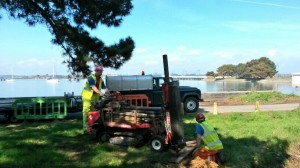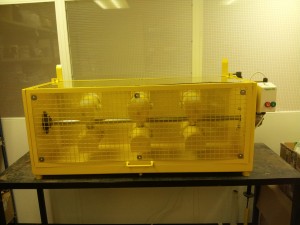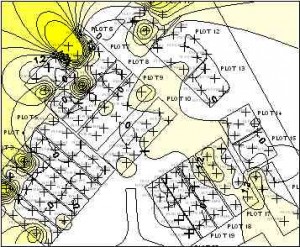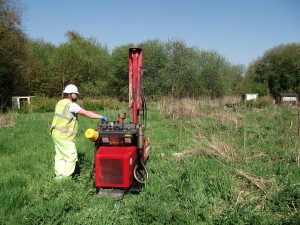
Sometimes it really just isn’t that bad to be on site! Could this be the start of a long, hot summer? We hope so.

Geo-Environmental Services

We’ve recently upgraded our laboratory’s facilities for waste classification (WAC) analysis. We already offer the fastest turnaround analysis in the UK, but we can now analyse a greater number of samples after installing our new soil tumbler. Designed and fabricated in-house, this allows us to simultaneously complete the leachate stage of the analysis on an additional 12 samples per day. These can either be samples supplied by our clients or samples taken by our technicians at clients’ sites.
If you’d like to know more about our WAC analysis or if you are a laboratory and would like to purchase a similar soil tumbler, then please contact Duncan Eastland – 01296 739431.

Subadra have recently completed what has been, perhaps, our trickiest ever underground tank removal. The tanks at the former filling station were located close to the site boundary. Removing them might destabilise a Victorian house on the adjacent property. To prevent this a contiguous bored pile wall was installed together with a supporting steel truss. Our job was to safely ease the tanks out from under the truss without compromising its structural integrity, before cutting them up and disposing of them as scrap metal. All this on a crowded site with construction of the new structures well underway.
Contract Value £20-£50k
Subadra has just completed environmental investigations at a portfolio of 25 retail petrol filling station sites on behalf of a major oil company. The project was brought to completion on time and on budget, using a combination of our own drilling equipment, our in-house UKAS accredited laboratory and reported by our highly experienced consultants.
Contract Value: £100-200k
Allotment holders in Great Kingshill are rejoicing at the results of our recent soil testing that has confirmed the soil at the site is not contaminated as a result of fly-tipping and that they don’t have to pull up their winter brassica. The sprouts for Christmas dinner have been saved! For more details see Bucks Free Press.

Otherwise known as ‘understand your audience’.
We have recently completed a highly complex site investigation and detailed risk assessment of a public amenity site on behalf of a Local Authority. Our technical report, however, needed to be understood by a wide range of stakeholders, including regulators, consultants, site users and the general public. We used a range of graphical presentation methods in our report, cut the industry acronyms to a minimum and offered a report written in ‘plain English’. The result? Clear advice and a happy client, who described our report as ‘a model of site investigation & risk assessment communication’.
It has become increasingly common in recent years for filling station operators to rely on remote wetstock monitoring to detect possible leaks in their system. Tank and pump gauges are monitored remotely with sophisticated trend analysis used to detect abnormal behaviour. These systems can be very good, but they aren’t infallible.
Last year Subadra were retained to clean up contamination resulting from a leak at a filling station. Our treatment was completed successfully over the winter months and by mid-summer we had started post-remedial monitoring, with groundwater samples taken at monthly intervals from monitoring wells we had installed at the site.
Our consultants noticed some anomalous results appearing and, in best CSI fashion, our laboratory carried out a programme of forensic analysis. This was able to determine the ‘age’ of the contamination we were finding, telling us how long the leaked fuel had been in the ground. This confirmed that the wells were being contaminated from a new source.
The site’s real-time remote wetstock monitoring was checked but didn’t show a leak at the site. However, on our advice, the site operator had the tanks and lines pressure tested and this identified a steady slow leak from one of the pumps. Repairs were carried out limiting the volume of fuel lost into the ground.
The moral of the tale? Well, remote wetstiock monitoring is very good and we would certainly recommend it. But it’s not infallible. In those cases, forensic analysis can help identify leaks that wetstock monitoing misses.
If you’d like to know more about our forensic analysis service or any of the other services offered by our UKAS/MCerts accredited laboratory please contact Kate Clark.
Subadra have been retained by a major food wholesaler/distributor to carry out a comprehensive audit/investigation of the fuel storage and supply infrastructure at a multi-site portfolio across the UK. Key to winning the contract was our ability to complete the project within a tight timescale. This is only possible because of our unique approach whereby every aspect of the project will be carried out using in house resources, from borehole drilling through to laboratory analysis; and, of course, our competitive rates!

Sometimes you need a detailed ground investigation with large numbers of boreholes, utilising a variety of different investigation tools (drill rigs, plate bearing tests, pile probing etc), with data collected and assimilated over a period of days or even weeks, that delivers a detailed description of site geology and provides a well defined contaminant delineation.We can do this for you.
However, sometimes you need a basic no frills contamination survey that is both cost effective and done on a very fast turnaround.Here at Subadra we own and operate our own survey team, drill rigs, chemical analysis laboratory in addition to our team of highly skilled geotechnical and environmental consultants that are responsible for collating, assessing and the reporting the data we produce. This means we can carry out high quality, cost effective Phase One and Two contamination surveys within days.This service proves invaluable for may of out clients who are always on the lookout to purchase new sites to add to their portfolio and don’t want to lose out on a lucrative deal or, perhaps worse, get caught out by discovering contamination issues after the site has been purchased.

SPOSH? POSH? (insert baffling acronym of your choice here). Sometimes our industry really makes a meal of what should be a simple process. How do you determine if a site is contaminated or not? We think the answer is simple: do a decent site investigation!
We have recently been working at site that proved to be a classic example of a ‘cheap’ site investigation saving nothing. The original investigation was carried out by others four years ago. After many other consultants were hired but failed to provide any clear answers (or any answers at all) we were commissioned to break the impasse.
We constructed 180 boreholes on a 5m grid using one of our dynamic sampling rigs. Boreholes and sampling locations were surveyed using GPS allowing us to develop a 3D contaminant profile of the site. Finally
sufficient information is now available to allow our client to make sensible decisions regarding future use and/or remedial strategy for the site. All this without resorting to any obscure and baffling acronyms.